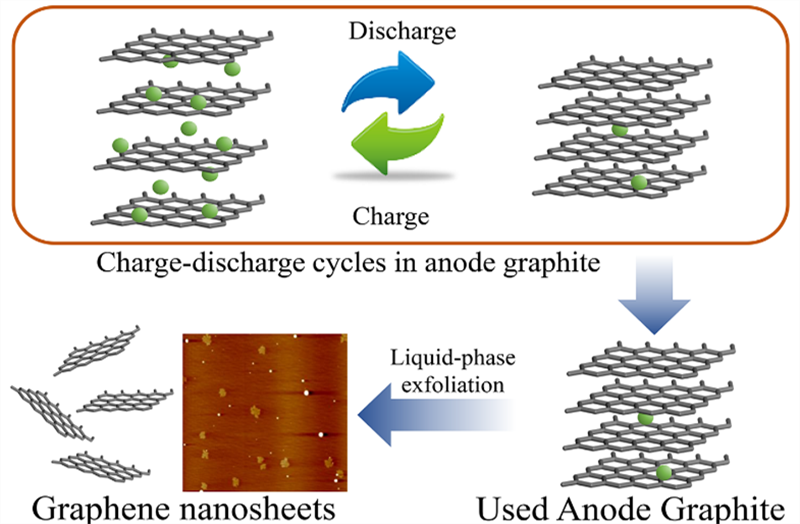Turning the Waste into Treasure: Prepare High-quality Graphene from Wasted Li-ion Batteries
Tianjin University (TJU) professor Fan Xiaobin recently prepared high-quality graphene with high yield by direct exfoliate anode graphite from used Li-ion batteries.
Nowadays, lithium-ion batteries have become widely used in our daily lives, and being essential for devices such as phones, smart wearable tech, and even smart cars. Several hundred thousand tons of lithium-ion batteries are being produced annually, while the increasing number of spent lithium-ion batteries are polluting our environment. Single-use batteries contain a number of materials that are recyclable. However, the current method of disposal, considering the high cost, is to bury batteries after only a few precious metals in them are recycled. But the recovery of the carbon anode materials of Li-ion batteries has not yet been realized.
As the building block of all graphitic forms of carbon material, graphene has attracted tremendous interest in energy storage devices, flexible electronics, solar cells, composite fillers, printed electronics, heterogeneous catalysis, and more. Therefore, significant advances have been achieved in producing graphene over the past decade.
For example, Novoselov and Geim firstly observed a single layer of graphene from highly oriented pyrolytic graphite using the micromechanical exfoliation method, despite the low yield of this “Scotch Tape Method”. For high yield production, redox method—which usually includes the oxidation of graphite, the exfoliation of the obtained graphite oxide and the reduction/deoxygenation of the graphene oxide—is the most popular way to prepare graphene, especially on an industrial scale. However, residual oxygen functional groups and abundant defects introduced by the oxidation and reduction/deoxygenation process completely disrupt the ideal sp2 network and significantly degrade the electronic and mechanical properties. On the other hand, chemical vapor deposition is the most promising approach to fabricate graphene of a high-quality and a large-area. But wafer-scale growth of single-crystalline graphene, the complex post growth transfer process, as well as the high cost remain as great challenges. Alternatively, sonication assisted liquid-phase exfoliation (LPE) of graphite seems to be the best compromise, not only because of the low-defect nature of the obtained graphene, but also its easy processability and potentially low cost.

Illustration of preparation of graphene with used anode graphite by liquid-phase exfoliation.
Recently, Fan’s group found that the pre-intercalation of layered materials like MoS2 with lithium ion could significantly increase their exfoliation efficiency by LPE. Obvious reduction in the averaged layered numbers of the obtained nanosheets was also observed. So, they noticed that the carbon anode materials in the wasted lithium-ion batteries after repeated intercalation may be a cheap and ideal candidate for the high yield production of high-quality graphene by the LPE method. To test this idea, they systematically investigated the direct liquid exfoliation of used anode graphite (UAG) from wasted batteries in both aqueous surfactant solution and the solvent mixture. They found that the exfoliation efficiency of the used anode graphite can be 3 to 11 times higher than the natural graphite, with a highest mass yield of the dispersed graphene sheets of ~40 wt%. Importantly, the layer numbers of most the exfoliated graphene are 1–4 layers, and their lateral sizes are over 1 um. Their conductivity after annealing at moderate temperature (500 °C) is up to 9100 S m–1, and their potential application in conductive ink was also demonstrated.
This interesting study not only provides a new way to prepare high-quality graphene with high yield, but also an important strategy for the recovery of Li-ion batteries.

(a) Digital image of a free-standing film. (b) Cross-section SEM image of the film in (a). (c) Digital image of electrical circuit drawn by a rollerball pen on common paper.
Editors: Qin Mian and Christopher Peter Clarke

